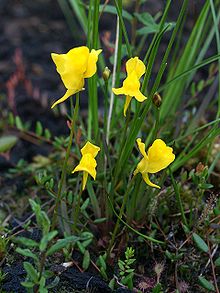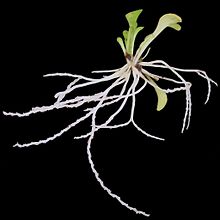Insectivorous or carnivorous plants are plants that get their nutrients by trapping animals, usually insects or protozoans, and other arthropods and digest their protein. They grow in places where the soil the soil deficient in nitrogen. Charles Darwin wrote 'Insectivorous Plants', the first well-known treatise on carnivorous plants, in 1875
The carnivorous plants use five basic trapping techniques. They are
1. Pitfall traps
2. Flypaper traps
3. Snap traps
4. Bladder traps
5. Lobster-pot traps
A. The Pitcher plant (Nepenthes)
Here, the ends of the leaves look like a pitcher containing water in which the plant traps insects (pitfall trap technique). Insects wandering nearby slide into the pitcher. The inner wall of the pitcher secretes proteolytic enzymes which help the plant to utilise the insect as food. The pitcher plant is a climber. These plants live in areas of high rainfall in South America. The pitcher is formed from the lamina of leaf and the lid is the modified leaf tip.
 |
| Source: ScienceDaily |
Pitcher Plant Uses Rain Drops to Capture Prey-
During heavy rain, the lid of Nepenthes gracilis pitchers acts like a springboard, catapulting insects that seek shelter on its underside directly into the fluid-filled pitcher, new research has found. The findings were published June 13, in the journal PLoS ONE.
B. Sundew (Drosera) plants
It is herbaceous plant growing in water logged places. the upper poration of its leaves have club shaped tentacles. the tentacle heads secrete sticky purple juice that shines in the sun (hence called sundew). It uses flypaper traps. an insect touching a tentacle is stuck up and trapped by bending of tentacles. the trapped insects is then digested by enyme secreted by digestive glands and amino acids are absorbed by the leaf.
C. Venus fly trap (Dionaea)
 |
| Source: National Geographic |
C. Venus fly trap (Dionaea)
| Source: Wikipedia Commons |
Charles Darwin described the Venus flytrap as "one of the most wonderful plants in the world."
It is a herbaceous plant bearing rosette leaves. The lamina of the leaf is modified into toothed jaws (bilobed) normally open at an angle forming a trap. Each jaw contains several teeth. they use Snap trap mechanism to catch their prey. The snapping of the leaves is a case of thigmonasty (undirected movement in response to touch). Stimulation of a sensitive spine or hair by an insect causes foldinf of leaf and secretion of digestive juices.
D. Bladder wort (Utricularia)
It is a rootless aquatic plant with highly dissected leaves. Some of the leaf segments are modified into small bladders which have trap valves (Bladder traps) for catching small animals like Cyclops and Daphnia.
E. Corksew plant (Genlisea)
It grows in wet terrestrial to semi-aquatic environments distributed throughout Africa and Central and South America. The plants use highly modified underground leaves to attract, trap and digest minute microfauna, particularly protozoans.
D. Bladder wort (Utricularia)
 |
| Source: Wikipedia Commons |
E. Corksew plant (Genlisea)
 |
| Source: Wikipedia Commons |
No comments:
Post a Comment